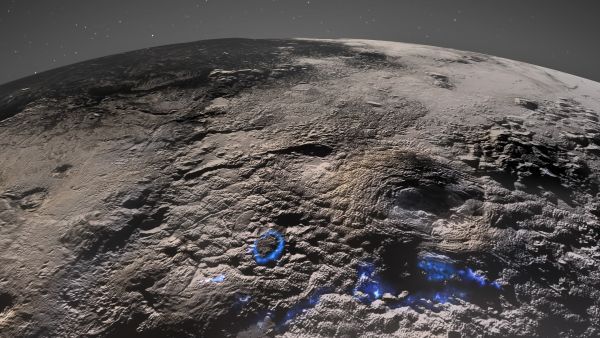Ice volcanoes on Pluto may still be erupting
By Rebecca Sohn published about 5 hours ago
More heat under the dwarf planet's surface could even hint at the potential of life.

An image of Pluto taken by the New Horizons probe in 2015 with evidence for
potential cryovolcanism marked in blue. (Image credit: NASA/Johns Hopkins University
Applied Physics Laboratory/Southwest Research Institute/Isaac Herrera/Kelsi Singer)
An area of Pluto that researchers think was formed from the eruption of ice volcanoes is unique on the dwarf planet and in the solar system, a new study suggests.
NASA's New Horizons mission, which launched in 2006, took detailed photos of the surface of Pluto, a dwarf planet and the largest object in the Kuiper Belt. Now, a new analysis examines images of an area containing two main mounds that scientists have proposed are ice volcanoes. In the study, the researchers conclude that the surface around these mounds was likely formed by fairly recent activity of the ice volcanoes, or cryovolcanoes.
The finding raises the possibility that these volcanoes may still be active and that liquid water, or something like it, flows or recently flowed under the surface of Pluto. Recent activity also means that there is likely more heat in Pluto's interior than scientists previously thought. Given other recent research, the scientists say their work could even raise the possibility of life existing under Pluto's surface.
The researchers analyzed photographs of a region dominated by two large mounds, called Wright Mons and Piccard Mons, which scientists think are cryovolcanoes. Wright Mons is a mount 2.5 to 3 miles (4 to 5 kilometers) high and about 90 miles (150 km) wide, while Piccard Mons is about 4 miles (7 km) high and 150 miles (250 km) wide.
More:
https://www.livescience.com/ice-volcanoes-pluto-possibly-erupting
